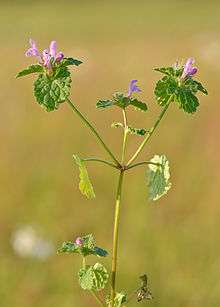Lamium
| Lamium | |
|---|---|
 | |
| Lamium purpureum | |
| Scientific classification | |
| Kingdom: | Plantae |
| (unranked): | Angiosperms |
| (unranked): | Eudicots |
| (unranked): | Asterids |
| Order: | Lamiales |
| Family: | Lamiaceae |
| Subfamily: | Lamioideae |
| Tribe: | Lamieae |
| Genus: | Lamium L.[1] |
| Type species | |
| Lamium purpureum L. | |
| Synonyms[2] | |
| |
Lamium (dead-nettles) is a genus of about 40–50 species of flowering plants in the family Lamiaceae,[3] of which it is the type genus. They are all herbaceous plants native to Europe, Asia, and northern Africa, but several have become very successful weeds of crop fields and are now widely naturalised across much of the temperate world.[2][4][5]
Description
The genus includes both annual and perennial species; they spread by both seeds and stems rooting as they grow along the ground. They have square stems[6] and coarsely textured pairs of leaves, often with striking patterns or variegation. They produce double-lipped flowers in a wide range of colours.[7]
The common name "dead-nettle" refers to the resemblance of Lamium album[8] to the very distantly related stinging nettles, but unlike those, they do not have stinging hairs and so are harmless or apparently "dead".
Several closely related genera were formerly included in Lamium by some botanists, including Galeopsis (hemp-nettles) and Leonurus (motherworts).
Cultivation
Lamium species are widely cultivated as groundcover, and numerous cultivars have been selected for garden use.[7] They are frost hardy and grow well in most soils. Flower colour determines planting season and light requirement: white- and purple-coloured flowered species are planted in spring and prefer full sun. The yellow-flowered ones are planted in fall (autumn) and prefer shade. They often have invasive habits and need plenty of room.
Ecology
Lamium species are used as food plants by the larvae of some Lepidoptera species including Angle Shades, Setaceous Hebrew Character and the Coleophora case-bearers C. ballotella, C. lineolea and C. ochripennella.
- Species[2]
- Lamium album L. – (white dead-nettle) – widespread across Europe + northern Asia from Spain + Norway to Japan + Kamchatka; naturalized in New Zealand + North America
- Lamium amplexicaule L. – (henbit dead-nettle) – widespread across Europe and northern Asia from Spain + Norway to Japan + Kamchatka, as well as North Africa, Ethiopia, Azores, Madeira, Canary Islands; naturalized in New Zealand, Hawaii, South America + North America
- Lamium bifidum Cirillo – Mediterranean from Portugal to Romania
- Lamium caucasicum Grossh. – Caucasus (southern European Russia, Armenia, Georgia, Azerbaijan)
- Lamium confertum Fr. – northern Europe from Ireland to northern Russia; naturalized in Greenland + Iceland
- Lamium coutinhoi J.G.García – Portugal
- Lamium demirizii A.P.Khokhr. – Turkey
- Lamium eriocephalum Benth. – Turkey
- Lamium flexuosum Ten. – Spain, France, Italy, Algeria, Morocco, Tunisia
- Lamium galactophyllum Boiss. & Reut. – Turkey
- Lamium galeobdolon (L.) L. – northern + central Europe and western Asia from Spain + Denmark east to Iran + Western Siberia; naturalized in New Zealand + Madeira
- Lamium garganicum L. – Mediterranean + western Asia from Portugal to Kazakhstan + Saudi Arabia
- Lamium gevorense (Gómez Hern.) Gómez Hern. & A.Pujadas – Spain, Portugal, Corsica
- Lamium glaberrimum (K.Koch) Taliev – Crimea
- Lamium × holsaticum Prahl – central Europe (L. album × L. maculatum)
- Lamium macrodon Boiss. & A.Huet – Turkey, Caucasus, Syria, Iran, Iraq
- Lamium maculatum (L.) L. – (spotted white dead-nettle, purple dragon) – Europe + Middle East from Portugal to Turkey; also Gansu + Xinjiang Provinces of western China
- Lamium moluccellifolium (northern dead-nettle)
- Lamium moschatum Mill. – eastern Mediterranean (Greece, Turkey, Syria, Palestine, Cyprus)
- Lamium multifidum L. – Turkey, Caucasus
- Lamium orientale (Fisch. & C.A.Mey.) E.H.L.Krause – Turkey, Syria, Palestine
- Lamium orvala L. – Austria, Italy, Hungary, Slovenia
- Lamium purpureum L. (red dead-nettle) – northern + central Europe and western Asia from Spain + Denmark east to Caucasus + Siberia; naturalized in Korea, Taiwan, North America, New Zealand, Argentina, Falkland Islands
- Lamium taiwanense S.S.Ying – Taiwan
- Lamium tomentosum Willd. – Turkey, Caucasus, Iran, Iraq
- Lamium vreemanii A.P.Khokhr. – Turkey
References
| Wikimedia Commons has media related to Lamium. |
| Wikispecies has information related to: Lamium |
| Look up lamium in Wiktionary, the free dictionary. |
- ↑ Carl Linnaeus (1753) Species Plantarum, p. 579.
- 1 2 3 Kew World Checklist of Selected Plant families
- ↑ http://pss.uvm.edu/pss123/perlam.html
- ↑ Altervista Flora Italiana, Genere Lamium includes photos and distribution maps for Europe and North America
- ↑ Flora of China Vol. 17 Page 157 野芝麻属 ye zhi ma shu Lamium Linnaeus, Sp. Pl. 2: 579. 1753.
- ↑ Parnell, J. and Curtis, T. 2012. Webb's An Irish Flora. p. 355. Cork University Press. ISBN 978-185918-4783
- 1 2 RHS A-Z encyclopedia of garden plants. United Kingdom: Dorling Kindersley. 2008. p. 1136. ISBN 1405332964.
- ↑ Brown, V. K.; Lawton, J. H.; Grubb, P. J. (29 August 1991). "Herbivory and the Evolution of Leaf Size and Shape [and Discussion]". Philosophical Transactions of the Royal Society B: Biological Sciences. 333 (1267): 265–272. doi:10.1098/rstb.1991.0076.
... appearance of vegetative plants of white dead-nettles (Lamium album) (Labiatae) bear a close resemblance to stinging nettles (Urtica dioica) (Urticaceae). Stinging hairs deter soft-muzzled, grazing mammals, suggesting that dead-nettles are harmless Batesian mimics. However, many other labiates that do not closely mimic nettles have ovate leaves with serrate margins, so if this is a case of true mimicry, it may have involved rather little modification in leaf shape. ...